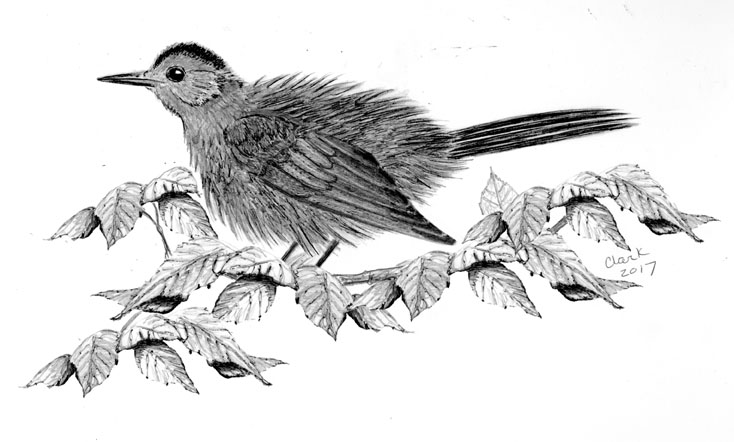
Dear Bird Folks,
Last week you wrote about orioles coming to feeders filled with grape jelly. We also put out jelly, except our feeder mostly attracts catbirds (which is fine with me). Recently, however, our jelly feeder has been deserted. At first I thought the catbirds had left for the year, but I can still hear them around the yard. Why have they lost interest in our jelly?
– Dylan, Eastham, MA
It’s not the jelly’s fault, Dylan,
The jelly is fine. Never blame anything bad on delicious jelly. The reason why catbirds have avoided your feeder has more to do with vanity than diet. At the end of last week’s column I mentioned that some cardinals are turning “bald“ and this temporary balding is associated with their annual molt. Well, catbirds aren’t going bald, but they too are in the process of molting. But unlike cardinals that seem to be oblivious to their new goofy looks, catbirds are far more self-conscious. They prefer not to be seen in public if they don’t look their very best (which is something catbirds and I have in common). In other words, they are merely lying low until their feathers grow back. But don’t put the jelly away, just yet.
As their name suggests, gray is the featured color of Gray Catbirds. With the exception of a black cap and a small rufous patch under their tails, these birds are all gray. But what catbirds lack in flashy coloring they make up for in personality. Next to chickadees (another gray bird), catbirds may be our most affable birds. They are extremely friendly and endlessly inquisitive. My wife claims that whenever she is working in her garden a catbird will follow her every step of the way. I can actually hear her talking to the bird while she is pulling weeds. She calls it her “friend.” In reality, the bird is just hoping her digging will expose a yummy bug or two. But since my wife doesn’t have many human friends, I let it go.
When catbirds aren’t hunting for bugs, they are devouring assorted fruit and berries. (I realize that fruit and berries are basically the same thing, but it sounds more impressive if I list them separately.) In addition to jelly, catbirds are also fond of raisins, which is what we feed them in our yard. I put out the raisin feeder each morning and bring it inside at night in order to keep the nocturnal raccoons from stealing it. When I wake up the next day, the catbirds are always lined up, waiting for me…and their raisins. Sometimes a hungry bird will fly right inside and grab a raisin before I’ve had a chance to carry the feeder outside. At first I found this to be amusing, but now I wish they were strong enough to open the door themselves so I could sleep late for a change.
In addition to their friendliness, catbirds are noted for their vocalizations. I think we are all familiar with their typical “mew” call, but their actual songs are far more impressive. Like mockingbirds, catbirds mimic the songs of other birds. But unlike mockers, which sound much like the original, catbirds tend to improvise by adding a few random squeaks and chirps. (Basically, catbirds are like jazz singers, only a lot more pleasant to listen to.) From the minute they arrive in May, their showy songs can be heard from sunup until sunset. But it all changes in August. Once the molting process begins the birds quit singing, hunker down in the thickets and only occasionally give their mew call just to let us know they are still around. During this period, my raisin feeder is virtually ignored and my wife has no one to talk to. Once in a while I’ll see a catbird peeking out from the vegetation and it looks rather disheveled, like it just crawled out of a clothes dryer.
Your catbirds will remain fairly hidden for a few weeks, Dylan. But after their molting is completed, they’ll likely return to your jelly (or raisin) feeder for a few more visits, before finally packing up and heading south for the winter. If you are like me, you’ll probably be sad when they finally leave. Things aren’t quite the same without their cheery song and inquisitive visits. But if you feel bad about it, how do you think my wife feels? She has to go back to talking to humans.
On a different topic:
This is my annual warning about buggy birdseed. Meal moths, which may be in your birdseed (in the form of eggs) when you buy it in the store, hatch in hot weather. These moths are harmless, but can turn your seed into a wormy, webby mess. They can also infest your kitchen. To prevent an infestation, don’t keep old seed hanging around, and if possible, store your seed in a shed or garage. Also, wash out your storage containers each time you refill them. Moths growing in bits of leftovers could infect your fresh seed. Finally, until the weather cools off, only buy the amount of seed you can use in a few weeks. There, you’ve been warned…again.